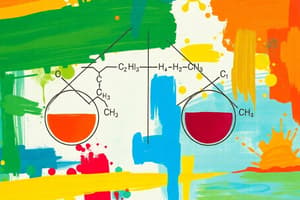Podcast
Questions and Answers
Why is balancing chemical equations a fundamental concept in chemistry?
Why is balancing chemical equations a fundamental concept in chemistry?
- To analyze the odor produced in a chemical reaction
- To regulate the temperature change during a reaction
- To ensure the number of atoms of each element remains constant in a reaction (correct)
- To determine the color of substances in a reaction
What does the Law of Conservation of Mass state?
What does the Law of Conservation of Mass state?
- Atoms can be created during a chemical reaction
- Mass cannot be created or destroyed during a chemical reaction (correct)
- Elements can change into different substances during a chemical reaction
- Molecules are destroyed during a chemical reaction
In balancing chemical equations, why is it important to conserve atoms?
In balancing chemical equations, why is it important to conserve atoms?
- To decrease the temperature change in the system
- To eliminate any smell produced during the reaction
- To increase the rate of reaction
- To prevent the creation or destruction of matter (correct)
What does a balanced chemical equation indicate about atomic ratios?
What does a balanced chemical equation indicate about atomic ratios?
How do electrons behave in chemical reactions?
How do electrons behave in chemical reactions?
Which statement accurately reflects the principle of conservation during a chemical reaction?
Which statement accurately reflects the principle of conservation during a chemical reaction?
Flashcards are hidden until you start studying
Study Notes
Balancing Chemical Equations is a fundamental concept in chemistry because it helps chemists determine how much of each substance is needed for a reaction to occur. This process involves balancing the number of atoms of each element on both sides of the equation so that they are equal to one another.
To balance a chemical equation, you need to follow three rules based on the Law of Conservation of Mass:
- Atoms must be conserved through a chemical reaction. In other words, if there were 6 carbon atoms before the reaction started, after the reaction has happened, there will still only be 6 carbon atoms present. If there was an atom of oxygen, there would also have been 2 atoms, and now there still needs to be two atoms in total. So any material is neither created nor destroyed during a chemical reaction.
- When elements react with each other, some form compounds which can contain almost any ratio of elements found naturally, or even unnatural ratios. For example, sulfur dioxide contains one atom of sulfur for every two atoms of oxygen. A balanced chemical equation tells us what these atomic ratios are like.
- Electrons may appear separately from their nuclei in chemical reactions. They behave just like atoms do, except that instead of having 6 protons around them inside the nucleus, it's 7. Or maybe it's 9 or 3... Different substances can have different numbers of electrons attached to them.
By following these rules, chemists can accurately predict how many particles of each type will be produced when a given set of materials undergoes a particular transformation. By keeping track of how many molecules exist before and after the reaction takes place, chemists ensure they know exactly where everything went.
Studying That Suits You
Use AI to generate personalized quizzes and flashcards to suit your learning preferences.




